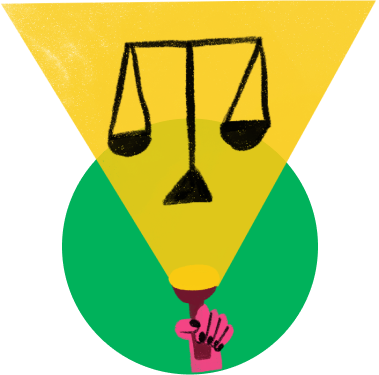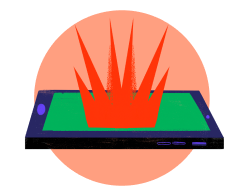To combat online violence, we must address the problem in a comprehensive way: it is important to work on the psychosocial well-being of people who are victims of violence, while improving our ability to report the violence, through the knowledge of the relevant national and international laws and the response mechanisms that exist to deal with it.
Taking control over our own information and our digital processes is the most subversive way to confront the systematic violence directed towards women and minority groups.

Actions needed to drive change
Comprehensive legal frameworks
Although there has been progress in implementing criminal laws that punish non-consensual distribution of intimate material, most States have not yet integrated into their legal frameworks a full recognition of digital violence as a form of gender-based violence against women. Laws must include clear, precise definitions and criminal classifications of online gender-based violence or violence facilitated by new technologies, ensuring they are non-restrictive and align with international human rights standards. This should consider the various forms of digital violence, the mechanisms by which it is carried out, its connection with other forms of violence, its impact on the victim's life and its occurrence in the context of an intimate relationship.
Paraguay has Law 5777/16 [for the comprehensive protection of women against all forms of violence](https://www.bacn.gov.py/leyes-paraguayas/8356/ley-n-5777-de-proteccion-integral-a-las-mujeres-contra-toda- forma-de-violencia), which contemplates telematic violence, understood as “any action that results in the dissemination or publication of messages, photographs, audios, videos, or others that affect the dignity or intimacy of women, through current information and communication technologies. This also includes using these media to promote the objectification, subjugation, or exploitation of women”. While the inclusion of telematic violence in the law is an important step forward, it is worth noting that the definition is still incomplete as it focuses solely on the non-consensual sharing of intimate images.
In addition, since 2023 the National Congress has been discussing a new bill to prevent, punish and eradicate universal cyberbullying in Paraguay. This initiative faces significant challenges, but also represents an opportunity to improve and update Law 5777/16, which addresses all forms of violence against women in Paraguay, explicitly incorporating digital violence.
Availability of data and financial resources
It is critical to prioritize the collection, analysis and use of data regarding the needs and vulnerabilities of marginalized groups of women and girls.
Private companies, such as internet service providers, can demonstrate their commitment by sharing information about the extent of various forms of online gender-based violence occurring on their digital platforms and facilitated by ICTs.
It is also essential to allocate adequate budget resources to combat online gender-based violence against women.
Additionally, it is crucial to ensure that civil society and women's rights organizations receive flexible funding to support decisions and policies on gender-based violence, which would enable them to play a central role in implementing effective prevention and response measures.
Protection, access to justice and comprehensive reparation for victims
It is important to implement straightforward, quick, and accessible judicial remedies that can effectively prevent TFGBV against women and protect them from revictimization, both online and offline. This includes ensuring that victims can obtain protection orders that prevent perpetrators from disseminating material without their consent or committing other forms of digital violence. In addition, law enforcement, prosecutorial, and judicial authorities must ensure a coordinated, swift, and immediate response, alongside accessible and effective reporting mechanisms.
Prevention and response to TFGBV against women
It is essential to integrate a digital perspective into programs for preventing and addressing family and intimate partner violence, providing digital safety tools to victims.
Likewise, action protocols should be established to prevent and address TFGBV in the school environment.
It is necessary to train front-line workers handling cases of digital violence against women and girls, enabling them to understand its characteristics, manifestations, and connection to offline violence, so they can provide victims with digital safety tools, helping them to strengthen their protection and prevent this violence.
In addition, awareness and training programs on TFGBV should be developed for security and justice personnel to enhance their ability to investigate and address this type of violence.
Educational programs and campaigns for digital literacy and the prevention of TFGBV against women
It is important to implement educational programs in collaboration with schools, universities and civil society organizations to promote digital literacy and empowerment of girls and women from a gender perspective. These programs should focus on developing knowledge about digital security, as well as the protection of privacy and identity online.
It is also important to promote educational programs about the safe use of digital technologies for children and adolescents, along with initiatives to raise awareness of the seriousness of online gender-based violence. Special attention must be given to the harm caused by cyberbullying, cyber harassment, and the non-consensual sharing of intimate images.These programs should include training for teachers, as well as for mothers and fathers, so that they can take the necessary protection and care measures against any form of online gender-based violence, abuse or aggression. These programs should include training for teachers as well as for mothers and fathers, so that they can take the necessary protection and care measures against any form of online gender-based violence, abuse or aggression.
Commitment from the private sector, with focus on Internet intermediary companies
Internet intermediaries, social media platforms, and traditional media companies hold human rights responsibilities under the Guiding Principles on Business and Human Rights. The ten principles of the UN Global Compact also require companies to ensure that they are not complicit in human rights abuses.
It is necessary to design technology that addresses gender issues, promoting greater participation of women in the technology sector and fostering partnerships with civil society and women's rights organizations.
In addition, clear criteria must be established for addressing cases of TFGBV against women and girls, with mechanisms for reporting and requesting the removal of harmful content that are easy to use, accessible, visible, transparent, and non-technical. It is critical that terms of service, privacy and data protection policies, as well as online violence reporting tools, are fully written in local languages and accessible to all.
It is also crucial that the staff responsible for reviewing TFGBV reports speak the local language, understand the cultural context, and are trained in addressing cases of gender violence. Additionally, report handling must ensure transparency, and the procedures for submitting complaints should include annual public summaries of how reports were processed.
Collaboration with victims and judicial authorities is essential to ensure the provision of relevant information for investigating and punishing cases of TFGBV against women and girls.
Finally, it is necessary to guarantee the safety and privacy of women's personal data, in accordance with international human rights law, allowing the option of anonymous or pseudo-anonymous online profiles when necessary to protect their integrity, freedom of expression, privacy, personal development and right to a life free of violence.
Partnerships for defending human rights online and offline
Collaborate in a coordinated manner with civil society organizations that defend human rights on the Internet, as well as with Internet intermediary companies and public human rights institutions, to prevent online gender-based violence.
Promote international cooperation for the exchange of ideas and experiences, as well as the implementation of programs aimed at protecting women victims of online violence.
Documenting
Documenting and registering incidents
We recommend that you document the aggression received. This helps to generate records and evidence in the event that the attacks continue to occur, whether from the same or from different profiles. Registering the event involves taking note of what happened, and documenting means collecting all the information of each incident or attack, in order to be able to understand what happened, even after some time has passed.
Why is it important to have the documentation and registration?
It is important and necessary to do so in order to be able to identify the aggressors and/or file a complaint or report. It is recommended to register and document the following issues:
- Attacks
- Incidents (anything unusual that happens on our accounts or devices, as well as on the physical sphere)
How to document?
Create an incident log. You can find an example of how to do so here.
Organize the storage of the rest of the information, such as:
- Screenshots of unauthorized entries where date, device and IP address can be seen
- Screenshots of harmful messages where profile picture and date can be seen
- Screenshots of social media profiles from which someone is being attacked, including the profile picture
hink about the safest mechanisms to keep this documents safely up to date among the people of the organization. It is also recommended to save backups of the documents.
How to help others?
The episode of violence may not happen to us, but to other people close to us. It is important that in these cases, we are prepared and know how to act.
If you are a witness, do not share content that attacks women. Break the social impunity surrounding technology-facilitated gender violence. It is essential to reflect on whether we know someone who has experienced TFGBV and what our response was to such a situation, as our reaction could have intensified the violence against the victim.
Do not blame the victims of TFGBV. Women affected by this type of violence often suffer additional victimization due to harmful gender stereotypes, which are prohibited by international human rights law.
We recommend the following caring and support practices:
Offer your support:
-
If you are near a person that is being attacked, offer immediate assistance. Be aware that this person may feel overwhelmed and may not have clear instructions on how to be assisted. You must remain calm, with active attention and with patience. Try not to add pressure or stress.
-
In the case of doxing (when sensitive, detailed and abundant information about a person is published for malicious reasons), you can offer them a safe place to stay (like your home) if the person does not feel safe.
-
You can offer to handle their accounts on social media or other platforms, to give them a break in that task.
-
You can also review national and local laws and policies on dealing with online and offline harassment, to turn your knowledge into concrete actions that can help the person being attacked. You can visit the site of the acoso.online project, which seeks to provide tools and legal knowledge to help you in situations of digital violence, such as the non-consensual publication of intimate images and videos by electronic means.
-
Make yourself heard: you can try to make your voice be heard on your social platforms, discussing what is happening and talking about these types of violence.

